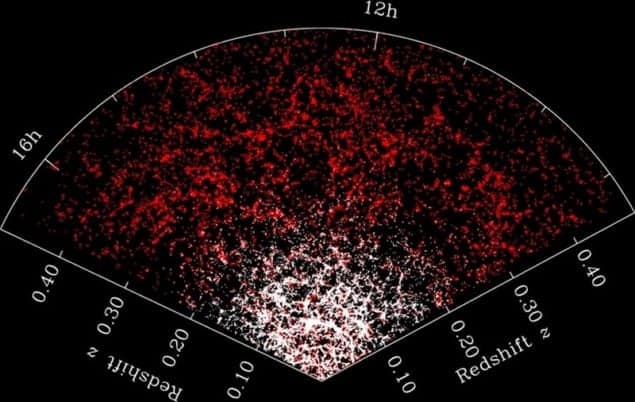
Einstein’s general theory of relativity has been tested for the first time over distances nearly as large as the universe itself – and has, in the process, trumped most other alternative theories of gravity. The test was done by astronomers in the US and Switzerland who studied images of more than 70,000 distant galaxies.
The team also concluded that the existence of vast quantities of invisible dark matter is the best way of explaining the motions of galaxies. The work also suggests that dark energy, in the form of a cosmological constant, is the best way of understanding how the universe is expanding
Since it was first published in 1916, Albert Einstein’s general theory of relativity has had great success in describing the motions of massive objects such as planets in the solar system. While the theory should also describe observations of galaxies and galaxy clusters on much greater length scales, this has proven very difficult to test.
In order to preserve general relativity, physicists must accept that about 80% of the matter in the universe is dark matter. This substance is invisible to astronomers, who can infer its presence from its gravitational interaction with galaxies. The problem is that the visible matter in galaxies appears to cluster more than dark matter, leading to a “galaxy bias” when astronomers try to map the total matter in the universe – and accurate maps are needed to test general relativity.
Cut the bias
This bias has been very difficult to resolve, but in 2007 Pengjie Zhang at the Shanghai Astronomical Observatory and colleagues in the US and UK proposed a new way of testing general relatively without having to worry about the bias. The test involves finding the ratio of two quantities called annular differential surface densities (ADSDs) – which are derived from images of galaxies.
One ADSD is related to how light from very distant galaxies is distorted by the gravitational fields of other galaxies that it passes on its way to Earth – an effect predicted by general relativity and called gravitational lensing. The second quantity is related to the velocities of the galaxies. The beauty of the new test is that both quantities are susceptible to bias – but the effects cancel in the ratio.
Now, Reinabelle Reyes and colleagues at Princeton University and the University of Zurich have derived these parameters from data on more than 70,000 distant galaxies from the Sloan Digital Sky Survey. The average distance to the galaxies is about 5.5 billion light-years – which means that the light has covered cosmological distances on par with the size of the universe.
Goodbye TeVeS?
The observed ratio, dubbed EG, has a value of 0.39 ± 0.06. This agrees with general relativity, which predicts a value of 0.4. Crucially, the measurement rules out the tensor, vector scalar (TeVeS) model of modified gravity, which has an EG of 0.22 and does not need dark matter. The result does not, however, preclude the f(R) theory – which is more similar to general relativity and has EG values in the 0.328–0.365 range.
So far, general relativity is coming up roses Robert Caldwell, Dartmouth College
“This work takes a significant step forward in using large-scale clustering data to constrain general relativity,” says Robert Caldwell at Dartmouth College in the US. Referring to this and other recent studies that have used gravitational lensing, he said, “so far, general relativity is coming up roses”.
‘So strange’
The study backs the view that the observed acceleration of the expansion of the universe is best explained by general relativity with a slowly varying cosmological constant – rather than by an alternative theory of gravity. The cosmological constant is a term introduced to represent the energy of empty space and prevent the universe from collapsing due to self gravity. It was abandoned by Einstein when it became clear that the universe was expanding – only to come back into favour in 1998 as a way of describing the dark energy that appears to be accelerating the expansion of the universe.
However, Caldwell stresses that this is not the last word on dark energy. “A cosmological constant is so strange that some of us really need to exhaust all alternatives before accepting it,” he says.
Zhang told physicsworld.com that he is very pleased that Reyes and colleagues have managed to measure EG – and added, “EG measurements will be significantly improved by ongoing surveys, so we expect more stringent tests on general relativity based on the EG measurement.”
Reyes and colleagues are eagerly awaiting the completion of the Baryon Oscillation Spectroscopic Survey (BOSS) in 2014 – which is expected to include about 1.5 million galaxies and could possibly rule out f(R).



